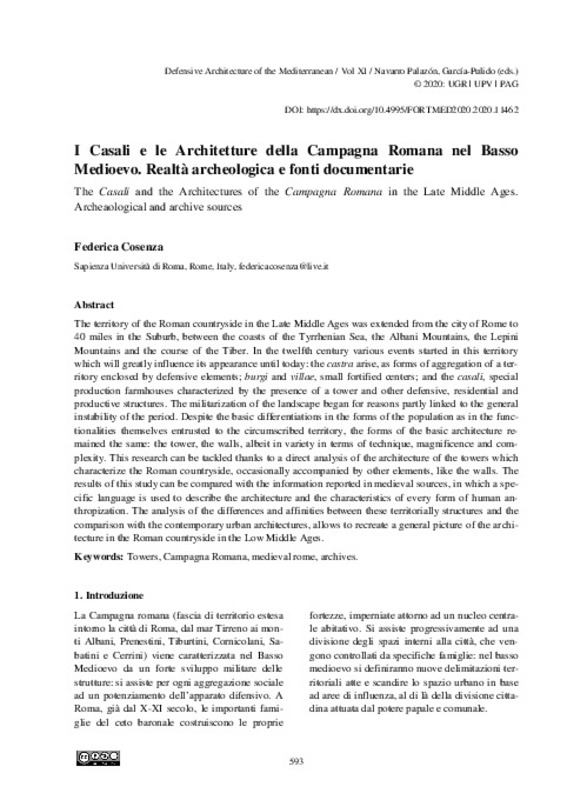JavaScript is disabled for your browser. Some features of this site may not work without it.
Buscar en RiuNet
Listar
Mi cuenta
Estadísticas
Ayuda RiuNet
Admin. UPV
I Casali e le Architetture della Campagna Romana nel Basso Medioevo. Realtà archeologica e fonti documentarie
Mostrar el registro sencillo del ítem
Ficheros en el ítem
| dc.contributor.author | Cosenza, Federica
|
es_ES |
| dc.date.accessioned | 2020-07-02T09:30:27Z | |
| dc.date.available | 2020-07-02T09:30:27Z | |
| dc.date.issued | 2020-05-15 | |
| dc.identifier.isbn | 9788490488560 | |
| dc.identifier.uri | http://hdl.handle.net/10251/147333 | |
| dc.description.abstract | [EN] The territory of the Roman countryside in the Late Middle Ages was extended from the city of Rome to 40 miles in the Suburb, between the coasts of the Tyrrhenian Sea, the Albani Mountains, the Lepini Mountains and the course of the Tiber. In the twelfth century various events started in this territory which will greatly influence its appearance until today: the castra arise, as forms of aggregation of a territory enclosed by defensive elements; burgi and villae, small fortified centers; and the casali, special production farmhouses characterized by the presence of a tower and other defensive, residential and productive structures. The militarization of the landscape began for reasons partly linked to the general instability of the period. Despite the basic differentiations in the forms of the population as in the functionalities themselves entrusted to the circumscribed territory, the forms of the basic architecture remained the same: the tower, the walls, albeit in variety in terms of technique, magnificence and complexity. This research can be tackled thanks to a direct analysis of the architecture of the towers which characterize the Roman countryside, occasionally accompanied by other elements, like the walls. The results of this study can be compared with the information reported in medieval sources, in which a specific language is used to describe the architecture and the characteristics of every form of human anthropization. The analysis of the differences and affinities between these territorially structures and the comparison with the contemporary urban architectures, allows to recreate a general picture of the architecture in the Roman countryside in the Low Middle Ages. | es_ES |
| dc.language | Italiano | es_ES |
| dc.publisher | Editorial Universitat Politècnica de València | es_ES |
| dc.rights | Reconocimiento - No comercial - Sin obra derivada (by-nc-nd) | es_ES |
| dc.subject | Fortifications | es_ES |
| dc.subject | Mediterranean | es_ES |
| dc.subject | Modern age | es_ES |
| dc.subject | Built Heritage | es_ES |
| dc.subject | Towers | es_ES |
| dc.subject | Campagna Romana | es_ES |
| dc.subject | Medieval Rome | es_ES |
| dc.subject | Archives | es_ES |
| dc.title | I Casali e le Architetture della Campagna Romana nel Basso Medioevo. Realtà archeologica e fonti documentarie | es_ES |
| dc.title.alternative | The Casali and the Architectures of the Campagna Romana in the Late Middle Ages. Archeaological and archive sources | es_ES |
| dc.type | Capítulo de libro | es_ES |
| dc.type | Comunicación en congreso | es_ES |
| dc.identifier.doi | 10.4995/FORTMED2020.2020.11462 | |
| dc.rights.accessRights | Abierto | es_ES |
| dc.description.bibliographicCitation | Cosenza, F. (2020). I Casali e le Architetture della Campagna Romana nel Basso Medioevo. Realtà archeologica e fonti documentarie. Editorial Universitat Politècnica de València. 593-600. https://doi.org/10.4995/FORTMED2020.2020.11462 | es_ES |
| dc.description.accrualMethod | OCS | es_ES |
| dc.relation.conferencename | FORTMED2020 - Defensive Architecture of the Mediterranean | es_ES |
| dc.relation.conferencedate | Octubre 01-03,2020 | es_ES |
| dc.relation.conferenceplace | Granada, Spain | es_ES |
| dc.relation.publisherversion | http://ocs.editorial.upv.es/index.php/FORTMED/FORTMED2020/paper/view/11462 | es_ES |
| dc.description.upvformatpinicio | 593 | es_ES |
| dc.description.upvformatpfin | 600 | es_ES |
| dc.type.version | info:eu-repo/semantics/publishedVersion | es_ES |
| dc.relation.pasarela | OCS\11462 | es_ES |








